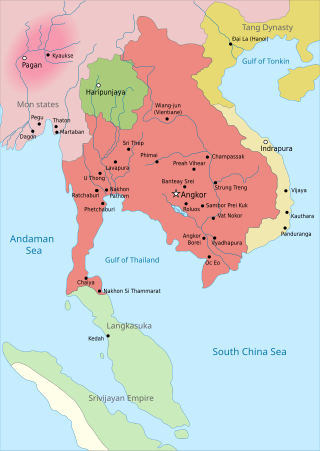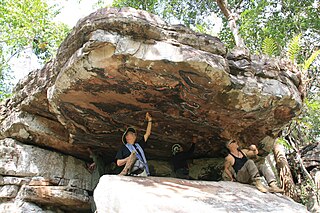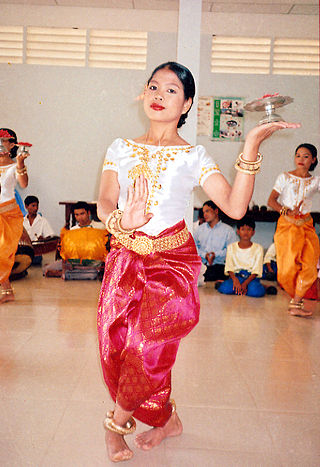
Khmer is an Austroasiatic language spoken natively by the Khmer people. This language is an official language and national language of Cambodia. The language is also widely spoken by Khmer people in Eastern Thailand and Isan, Thailand, also in Southeast and Mekong Delta of Vietnam.

Khmer architecture, also known as Angkorian architecture, is the architecture produced by the Khmer during the Angkor period of the Khmer Empire from approximately the later half of the 8th century CE to the first half of the 15th century CE.

Vietnamese is an Austroasiatic language spoken primarily in Vietnam where it is the official language. Vietnamese is spoken natively by around 85 million people, several times as many as the rest of the Austroasiatic family combined. It is the native language of ethnic Vietnamese (Kinh), as well as the second or first language for other ethnicities of Vietnam, and used by Vietnamese diaspora in the world.

The Brahmic scripts, also known as Indic scripts, are a family of abugida writing systems. They are used throughout the Indian subcontinent, Southeast Asia and parts of East Asia. They are descended from the Brahmi script of ancient India and are used by various languages in several language families in South, East and Southeast Asia: Indo-Aryan, Dravidian, Tibeto-Burman, Mongolic, Austroasiatic, Austronesian, and Tai. They were also the source of the dictionary order (gojūon) of Japanese kana.

Angkor, also known as Yasodharapura, was the capital city of the Khmer Empire, located in present-day Cambodia. The city and empire flourished from approximately the 9th to the 15th centuries. The city houses the Angkor Wat, one of Cambodia's most popular tourist attractions.

The Khmer Kingdom was a Hindu-Buddhist Kingdom in Southeast Asia, centered around hydraulic cities in what is now northern Cambodia. Known as Kambuja by its inhabitants, it grew out of the former civilisation of Chenla and lasted from 802 to 1431. Historians call this period of Cambodian history the Angkor period, after the empire's most well-known capital, Angkor. The Khmer Empire ruled or vassalised most of mainland Southeast Asia and stretched as far north as southern China. At its peak, the Empire was larger than the Byzantine Empire, which existed around the same time.

The early history of Cambodia follows the prehistoric and protohistoric development of Cambodia as a country in mainland Southeast Asia. Thanks to archaeological work carried out since 2009, this can now be traced back to the Neolithic period. As excavation sites have become more numerous and modern dating methods are applied, settlement traces of all stages of human civil development from neolithic hunter-gatherer groups to organized preliterate societies are documented in the region.
Khmer script is an abugida (alphasyllabary) script used to write the Khmer language, the official language of Cambodia. It is also used to write Pali in the Buddhist liturgy of Cambodia and Thailand.

Chenla or Zhenla is the Chinese designation for the successor polity of the kingdom of Funan preceding the Khmer Empire that existed from around the late 6th to the early 9th century in Indochina. The name was still used in the 13th century by the Chinese envoy Zhou Daguan, author of The Customs of Cambodia. It appears on the Mao Kun map. However, modern historiography applies the name exclusively to the period from the late 6th to the early 9th century. This period of Cambodian history is known by historians as the Pre-Angkor period. It is doubted whether Chenla ever existed as a unitary kingdom, or if this is a misconception by Chinese chroniclers. Most modern historians assert that "Chenla" was in fact just a series of loose and temporary confederations of principalities in the pre-Angkor period.

Khmer numerals are the numerals used in the Khmer language. They have been in use since at least the early 7th century.

The Khmer people are an Austroasiatic ethnic group native to Cambodia. They comprise over 95% of Cambodia's population of 17 million. They speak the Khmer language, which is part of the larger Austroasiatic language family alongside Mon and Vietnamese.

The Nyah Kur language, also called Chao-bon, is an Austroasiatic language spoken by remnants of the Mon people of Dvaravati, the Nyah Kur people, who live in present-day Thailand. Nyah Kur shares 69% lexical similarity with Mon, the only other language in the Monic language family.

The history of art stretches back centuries to ancient times, but the most famous period is undoubtedly the Khmer art of the Khmer Empire (802–1431), especially in the area around Angkor and the 12th-century temple-complex of Angkor Wat, initially Hindu and subsequently Buddhist. After the collapse of the empire, these and other sites were abandoned and overgrown, allowing much of the era's stone carving and architecture to survive to the present day. Traditional Cambodian arts and crafts include textiles, non-textile weaving, silversmithing, stone carving, lacquerware, ceramics, wat murals, and kite-making.

Hariharalaya was an ancient city and capital of the Khmer empire located near Siem Reap, Cambodia in an area now called Roluos. Today, all that remains of the city are the ruins of several royal temples: Preah Ko, the Bakong, Lolei.

Roneat is the generic Khmer word for referring to several types of xylophones used in traditional Cambodian music; the pinpeat and mohaori.

Middle Khmer is the historical stage of the Khmer language as it existed between the 14th and 18th centuries, spanning the period between Old Khmer and the modern language. The beginning of the Middle Khmer period roughly coincides with the fall of the Angkorian Khmer Empire to the Siamese Ayutthaya Kingdom and the period of Cambodian history popularly referred to as the Post-Angkor Period. The Middle Khmer period was a stage of transition which saw relatively rapid and dramatic changes, especially in phonology, that ended with the emergence of a language recognizable as Modern Khmer approximately concurrent with the 1777 coronation of Ang Eng, the father of the poet-king Ang Duong.
The fall of Angkor, also known as the sack of Angkor or siege of Angkor, was a seven-month siege of the Khmer capital Angkor by the Ayutthaya Kingdom. After the Khmer refused to recognize Ayutthaya authority, the Ayutthaya besieged Angkor and sacked the capital city. The Khmer King Ponhea Yat fled the city to Basan and later to Chaktomuk . Though the Khmer Empire was already in decline, the conquest of Angkor delivered the final blow and the empire fell. Angkor was subsequently abandoned. After the Fall of Angkor, the king moved the capital first to Basan and later to Chaktomuk, initiating the period known as the Post-Angkor period.

The pin is a Cambodian arched harp, one of the most historically important instruments in Cambodian music. The instrument went extinct c. 16th century, and is now being restored in modern times. Its historical importance is emphasized by the very name for Cambodian classical music, pinpeat. After the pin was no longer being used, Cambodians continued to use the instrument's name for classical music into the present era. When the pin was no longer being used, the tonal range of other instruments was expanded, possibly to compensate. Burmese saung gauk and roneats had more keys for the chromatic scale and the number of gongs in the kong von thom and kong toch "more than doubled in number since the musician depicted on the Angkorian carvings."

The Sukhothai script, also known as the proto-Thai script and Ram Khamhaeng alphabet, is a Brahmic script which originated in the Sukhothai Kingdom. The script is found on the Ram Khamhaeng Inscription and the Lö Thai inscription.

Khmer inscriptions are a corpus of post-5th century historical texts engraved on materials such as stone and metal ware found in a wide range of mainland Southeast Asia and relating to the Khmer civilization. The study of Khmer inscriptions is known as Khmer epigraphy.


















